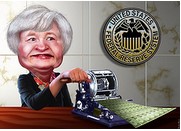 In 2013, President Obama nominated Janet Yellen to be the next Federal Reserve Chairman. We need to know what she stands for if we want to predict what the central bank will do to us next. Clearly, Yellen will continue Bernanke’s Quantitative Easing, but her papers and speeches show that she is quite different from her predecessor. (originally written in 2013, arguments still valid today)
In 2013, President Obama nominated Janet Yellen to be the next Federal Reserve Chairman. We need to know what she stands for if we want to predict what the central bank will do to us next. Clearly, Yellen will continue Bernanke’s Quantitative Easing, but her papers and speeches show that she is quite different from her predecessor. (originally written in 2013, arguments still valid today)
Let’s start by looking at Bernanke as a reference. Bernanke pays homage to the economist Milton Friedman, who is widely known for wanting basically free markets with a passive Fed. Less well known is Friedman’s advocacy of money pumping in a crisis. This explains the Bernanke we keep seeing on TV. A crisis erupted a few years after he took office (his arrival and the eventual crisis not unrelated), and so he has been madly pumping ever since. If the crisis somehow abated, he would stop. Bernanke is part central planner and part free marketer.
By contrast, Yellen is all central planner. She gets her ideas, not from Friedman, but from John Maynard Keynes. Keynes did not trust markets, preferring government intervention. His prescribed solution to recession and unemployment is for the government to increase spending and the central bank to reduce interest. Today, we call this form of governance “cronyism,’ but it once had another name. “Fascist economics” is how Italian dictator Mussolini approvingly characterized Keynes’ work.
Yellen is even more radical than Keynes, and believes intervention isn’t just for downturns. We see this belief in the theory of labor she presents in a key 1990 paper, and then the practical policy she proposes in a recent speech.
In the paper, Yellen and her coauthor discuss the cause of unemployment and how to eliminate it. Here is their tenuous chain of logic:
1. Disgruntled employees don’t work hard, and may even sabotage machinery.
2. So companies must overpay to keep them from slacking.
3. Higher pay per worker means fewer workers, because companies have a finite budget. Yellen concludes—you guessed it:
4. inflation provides corporations with more money to hire more people.
This theory is a frivolous rationalization for money printing, but Yellen has pragmatic reasons for it. If the Fed must print, then someone has to have their hand on the print button. Whoever controls money and credit wields enormous power, especially if printing is discretionary.
Turning to Yellen’s 2012 speech in New York, she proposes real policy. She is now president of the San Francisco Fed, and no mere academician as she was in 1990. She is open about her two long-run goals: zero interest rate, and two percent inflation. She couldn’t tell us any more clearly what she will do when she is in charge.
These two policies in combination will hit like a one-two punch. Think about a pension fund, which invests money to earn a yield to pay retirees. Obviously the yield has to be significantly above inflation. If not, the fund will have to pay out its principal and it won’t be viable for long. To generate a good return on assets in Yellen’s zero-interest world, funds will have to take big risks. That’s not likely to end well for pension funds or the retirees who depend on them.
Another disaster is coming, caused by zero interest and two percent inflation. Pensions, annuities, and insurers are going to default. Yellen speaks often about preventing crises with more “supervision.” She can certainly take control of funds’ investment decisions, and she can force them not to take risks. What she cannot do is get them a sufficient rate of interest.
How will market participants react to this new wave of bankruptcies? How will pensioners react? Yellen anticipates that they will demand further Fed intervention, to “cushion” the economy. The whole basis of her theory is that people cannot be trusted to make their own decisions, that the market shouldn’t be free.
Of course, every Fed intrusion is good for some people and bad for others. Billions of dollars are riding on the smallest of them. Every special interest group will try to pressure Yellen to rule in their favor. A more interventionist Fed is by its nature a more politicized Fed.
Look for these predictions to come true over 2014-2015: Interest rates will fall further as will economic freedom. Prices will not rise, but not for Yellen’s lack of trying. On the other hand, significant bankruptcies, Fed control of financial institutions, and the price of real estate in Washington will all be on the rise.
See more for




















